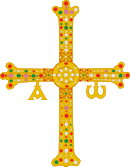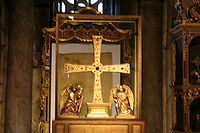- Cross of the Angels
-
Cross of the Angels Spanish: Cruz de los Ángeles Year 808 Type gold work Dimensions 46.5 cm × 45.7 cm (18.3 in × 18.0 in) Location Cámara Santa, Oviedo The Cross of the Angels (Asturian: Cruz de los Ánxeles) (Spanish: Cruz de los Ángeles) is a pre-romanesque Asturian reliquary donated by Alfonso II of Asturias in the year 808 to the Church of San Salvador in Oviedo, Asturias. The Cross of the Angels is the symbol of the city of Oviedo
The cross is the first example of jewelry made in the Kingdom of Asturias that has reached our days. His current appearance is the result of careful reconstruction carried out after the damages the cross underwent in August 1977 after the robery of the Camara Santa . Its squared dimensions (46.5 centimetres (18.3 in), 45.7 centimetres (18.0 in) wide and 2.5 centimetres (0.98 in) thick) are typical from Greek crosses. The cross is formed by two pieces of cedar wood with, at the center, a round disc.
Contents
History
The donation is usually interpreted as a sign of gratitude of the monarch after being restored to the throne, after the years of his incarceration in the monastery of Abelania.
Veneration of the True Cross in the Kingdom of Asturias
Reliquary
 Visigothic votive cross of the Treasure of Guarrazar, made of gold, precious stones, nacre and glass (7th century).
Visigothic votive cross of the Treasure of Guarrazar, made of gold, precious stones, nacre and glass (7th century).
“ Permanezca Esto Gratamente Acogido En Honor De Dios.Alfonso, Humilde Esclavo De Cristo, Lo Ofrece. Con Este Signo Se Protege Al Piadoso, Con Este Signo Se Vence Al Enemigo. Quien Se Atreviera A Arrebatarme, Excepto Donde Mi Libre Voluntad Me Dejare, Sea Muerto Por El Rayo Divino. Esta Obra Fue Acabada En La Era 846 [1] ” The lateral arms have kept the rings from which hang chains with pearls and precious stones, also known as pendilia, comparable to votive crosses and crowns of the Visigothic treasure of Guarrazar.
Symbol of the City of Oviedo
The Cross of the Angels became the symbol of the city of Oviedo around the 15th century, although it is said that even earlier, in 1262, it was used as a seal of the city. This is reflected in an engraving in the old city walls where the cross, with the Greek letters alpha and omega hanging of his arms, is used as a sign of consecration. Nowadays, the cross is present in the coat of arms of both the city of Oviedo and the Roman Catholic Archdiocese of Oviedo.
Notes
- ^ 808 in today's calendary
References
- Schlunk, Helmut (1985) (in Spanish). Las cruces de Oviedo : el culto de la vera cruz en el reino asturiano. Oviedo: Instituto de Estudios Asturianos (Oviedo, Spain). ISBN 8450513243. OCLC 20256995.
- Williams, Leonard (1907). "Gold, silver, and jewel work. Iron-work". The arts and crafts of older Spain. 1. London: T. N. Foulis. http://www.archive.org/details/artscraftsofolde01will.
- Fernández Somoza, Gloria (2004) (in Spanish). La Cruz de los Ángeles de la catedral de Oviedo. Oviedo: Hércules Astur. ISBN 84-86723-40-X.
- González, García; Vicente, José (1979) (in Spanish). La Cámara Santa y su tesoro. Oviedo: Principado de Asturias. ISBN 8430011927.
- Universidad de Oviedo (2002) (in Spanish). La restauración de las joyas históricas de la Cámara Santa de Oviedo : 1977-1997. Oviedo: Alvízoras. ISBN 8486889928. OCLC 166521733.
- http://www.arqweb.com/lucusaugusti/sello.asp
- http://el.tesorodeoviedo.es/index.php?title=Cruz_de_los_%C3%81ngeles
See also
Form of cross typical of Early Christian and Early Medieval art, where the cross, or at least its front side, is principally decorated with jewels. VIth- IXth century Cross of Justin II • Cross of the Angels • Cross of Agilulf • Cross of Duke Gisulf • Cross of the King Desiderius • Treasure of Guarrazar • Ardennes CrossXth century Victory Cross • Cross of Lothair • Cross of Mathilda and Otto • Cross of PeñalbaXIth century Cross of San Salvador de Fuentes • Cross of Stift EngerXIIth century Cross of Cong • Cross of Adelheid • Cross of ChersonesusPre-romanesque art in the Kingdom of Asturias Pre-Romanesque art in Asturias is framed between the years 711 and 925, the period of the rise and extension of the Kingdom of Asturias. Architecture 1st Period (737 to 791)Santa Cruz de Cangas de Onís • Church of San Juan Apóstol y Evangelista2nd Period (791 to 842)3rd period (842 to 866)Church of Santa María del Naranco • Church of San Miguel de Lillo • Church of Santa Cristina de Lena4th period (866 to 910)5th period (910 to 925)
Infrastructure La FoncaladaMajor figures Minor arts Cruz de la Victoria • Cruz de los Angeles • Sudarium of Oviedo • Agate boxSpiritual legacy Kingdom of Asturias (718–925) - Asturian architecture Categories:- Asturias
- Crux gemmata
- Reliquaries
Wikimedia Foundation. 2010.

